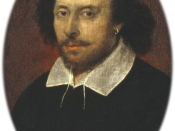To Be or Not To Be Analysis
"To be, or not to be"(III. 1. 57) is one of the most famous lines in William Shakespeare's play, Hamlet, Prince of Denmark. In the soliloquy of Act III scene one, Hamlet juggles around the idea of life or death. Hamlets soliloquy lays out his conception on whether he shall continue to live miserably or commit suicide. The soliloquy also reveals one of Hamlet's fears. Hamlet's monologue creates strong visualizations of his options "To be or not to be" (III. 1. 57).
In this soliloquy, Hamlet is flustered and ponders the idea of committing suicide. Why is hamlet confused and thinking about committing suicide? Hamlet is overwhelmed about the news of his father's death he has heard from the Ghost. He is baffled on whether to continue struggling through his misfortune or to contest against his troubles in life, specifically the revenge to justify his father.
"The slings and arrows of outrageous fortune, or to take arms against a sea of troubles, and by opposing end them?" (III. 1. 58-60). This quote is an implied comparison of Hamlet asking himself if he should continue to suffer by all the wrongs that he speculates as "outrageous fortune" (III. 1. 58 ) or to put up a fight against his miseries. Hamlet then starts to think death may resolve all of his issues. Hamlet compares death to sleep, "and by a sleep to say we end the heart-ache and the thousand natural shocks." (III. 1. 61-62). Therefore if he were to sleep all of his "heart-ache" (III. 1. 62) problems would wash away.
Hamlet then begins to consider that if one were to die, "to sleep" (III. 1. 60), there are possibilities of dreams. In other words just because one is dies...


